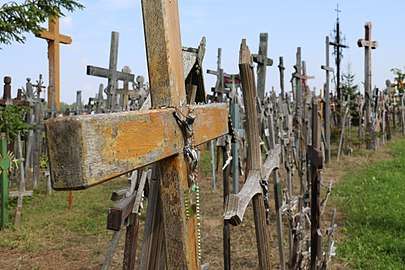Hill of Crosses
Hill of Crosses (Lithuanian: ![]()
History
Over the generations, the place has come to signify the peaceful endurance of Lithuanian people despite the threats they faced throughout history. After the 3rd partition of the Polish–Lithuanian Commonwealth in 1795, Lithuania became part of the Russian Empire. Poles and Lithuanians unsuccessfully rebelled against Russian authorities in 1831 and 1863. These two uprisings are connected with the beginnings of the hill: as families could not locate bodies of perished rebels, they started putting up symbolic crosses in place of a former hill fort.[1]
| Number of crosses[2] | |
|---|---|
| 1800s | over 9,000 |
| 1900 | 130 |
| 1902 | 155 |
| 1922 | 50 |
| 1938 | over 400 |
| 1961 | destroyed 5,000 |
| 1975 | destroyed 1,200 |
| 1990 | some 55,000 |
| 2006 | over 100,000 |
When the old political structure of Eastern Europe fell apart in 1918, Lithuania once again declared its independence. Throughout this time, the Hill of Crosses was used as a place for Lithuanians to pray for peace, for their country, and for the loved ones they had lost during the Wars of Independence.
The site took on a special significance during the years 1944–1990, when Lithuania was occupied by the Soviet Union. Continuing to travel to the hill and leave their tributes, Lithuanians used it to demonstrate their allegiance to their original identity, religion and heritage. It was a venue of peaceful resistance, although the Soviets worked hard to remove new crosses, and bulldozed the site at least three times (including attempts in 1963 and 1973).[4] There were even rumors that the authorities planned to build a dam on the nearby Kulvė River, a tributary to Mūša, so that the hill would end up underwater.[5]
On September 7, 1993, Pope John Paul II visited the Hill of Crosses, declaring it a place for hope, peace, love and sacrifice. In 2000 a Franciscan hermitage was opened nearby. The interior decoration draws links with La Verna, the mountain where St. Francis is said to have received his stigmata.[4] In May 2013, Šiauliai District Municipality adopted rules regarding the placement of crosses. People are allowed to erect wooden crosses less than 3 metres (9.8 ft) in height with no permits.[6]
In December 2019, a woman tourist from China removed and tossed away a cross believed to be set up by Hong Kong pro-democracy camp. She later condemned the protesters in a Twitter post and in an Instagram video saying, "We have done a good thing today. Our motherland is great."[7] Lithuanian Foreign Minister Linas Linkevičius condemned the woman's action in a tweet that called it a "shameful, disgraceful act of vandalism" and said such behavior "can't and won't be tolerated."[8]
Gallery
 Chapel
Chapel
 Hill of Crosses at night
Hill of Crosses at night
See also
- Lithuanian cross crafting
- Three Crosses – prominent monument in Vilnius, capital of Lithuania
- Žemaičių Kalvarija – pilgrimage site in Samogitia, Lithuania
- Khatchkars – Armenian monumental crosses.
References
- Semaška, Algimantas (2006). Kelionių vadovas po Lietuvą: 1000 lankytinų vietovių norintiems geriau pažinti gimtąjį kraštą (in Lithuanian) (4th ed.). Vilnius: Algimantas. p. 339. ISBN 9986-509-90-4.
- "Kryžių skaičius" (in Lithuanian). Lithuanian Millennium of Cultural Heritage Virtual Tour. Retrieved 2007-05-06.
- Tour to The Hill of Crosses Near Šiauliai Archived 2009-04-17 at the Wayback Machine. Retrieved 31 October 2009
- Jankevičiūtė, Giedrė (2006). Lietuva. Vadovas (in Lithuanian). R. Paknys press. pp. 256–257. ISBN 9986-830-97-4.
- "Kryžių kalnas" (in Lithuanian). Šiauliai bishop. Archived from the original on 2007-05-12. Retrieved 2007-05-06.
- Šiaulių rajono savivaldybės taryba (16 May 2013). "Kryžių kalno lankymo taisyklės" (in Lithuanian). Šiaulių rajono turizmo ir verslo informacijos centras. Retrieved 6 January 2020.
- "Lithuania outraged by Chinese tourist's removal of HK cross". AP NEWS. 2019-12-30. Retrieved 2020-04-21.
- Dapkus, Liudas (2019-12-30). "Lithuania outraged by Chinese tourist's removal of Hong Kong cross". CTVNews. Retrieved 2020-01-01.
External links
| Wikimedia Commons has media related to Kryžių Kalnas. |